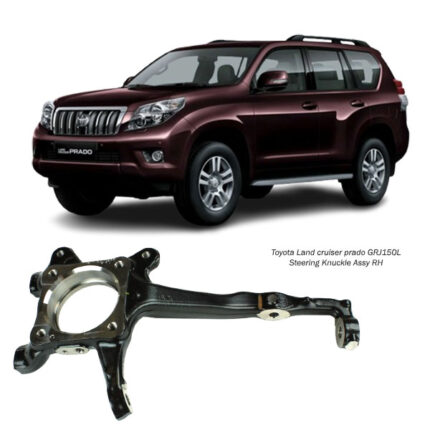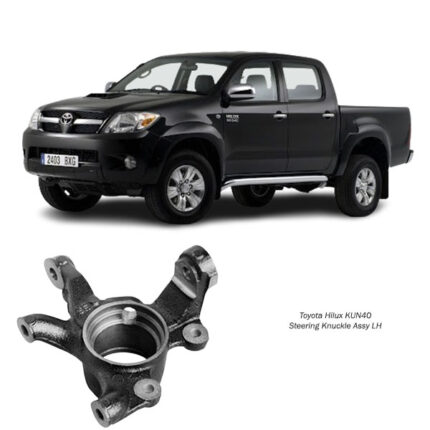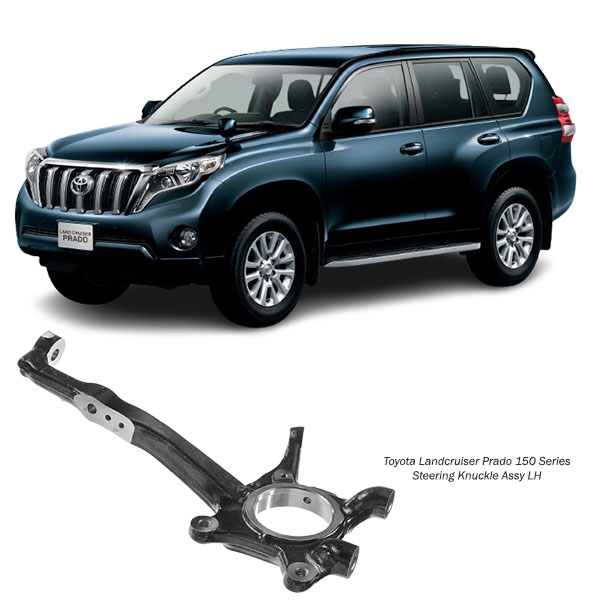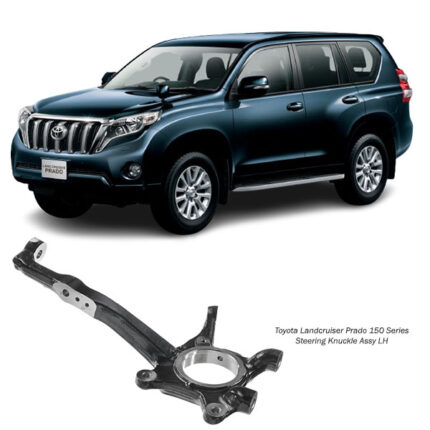Get Toyota Land cruiser Prado 150 Series Steering Knuckle Assy LH 43212-60240 in Kenya
The Steering Knuckle Assembly LH, or Left-Hand Steering Knuckle Assembly, is a core component in your vehicle’s front suspension and steering systems. Though it often stays behind the scenes, its function is vital—connecting major parts like the wheel hub, suspension arms, steering linkage, and braking components
This guide dives into the purpose, structure, signs of wear, and maintenance of the LH steering knuckle assembly. Whether you’re a car owner looking to understand your vehicle better, or a mechanic brushing up on knowledge, this breakdown will steer you in the right direction .
What Is the Steering Knuckle Assembly LH?
The steering knuckle assembly is a robust, complex part that serves as the pivot point for the front wheels. It links the suspension system, brakes, and steering system, while also holding the wheel hub where the wheel and tire mount.
“LH” stands for Left-Hand, meaning this specific assembly is installed on the driver’s side of left-hand drive vehicles or the passenger side of right-hand drive vehicles.
Unlike a simple arm, a knuckle assembly includes several mounting points and interfaces, often supporting ball joints, tie rods, strut mounts, and brake components.
Main Functions
1. Connecting Suspension to Steering
The steering knuckle serves as the link between the steering system and the wheel. When you turn the steering wheel, the motion is transmitted through the tie rods to the knuckle, causing the wheels to pivot.
2. Supporting the Wheel Hub
The knuckle assembly houses the wheel hub and bearing, enabling the wheel to rotate while being held securely in place. This allows smooth wheel movement and supports the vehicle’s weight at the same time.
3. Brake Mounting
Most front disc brake systems rely on the knuckle to hold the brake caliper bracket, ensuring the caliper can squeeze the brake rotor securely and consistently. Without this, braking force wouldn’t be applied effectively.
4. Suspension Geometry Control
The steering knuckle maintains camber, caster, and toe angles—key alignment factors that affect how your car handles, brakes, and wears tires. A bent knuckle can throw all this off.
Materials and Design
The knuckle assembly must be extremely durable, as it handles both dynamic forces (from steering and road contact) and static weight. It is usually made from:
-
Forged Steel – Very strong and used in heavy-duty or performance-oriented vehicles.
-
Cast Iron – Common and sturdy but heavier.
-
Aluminum Alloy – Lightweight and corrosion-resistant, often seen in modern designs.
The exact shape varies depending on the suspension setup—for instance, a MacPherson strut design will have different mounting points than a double wishbone system.
Symptoms of a Worn or Damaged LH Knuckle Assembly
If your steering knuckle assembly is compromised, it can lead to serious issues. Here are some telltale signs:
1. Uneven Tire Wear
A bent or misaligned knuckle will distort the wheel’s angle, causing the tires to wear unevenly.
2. Poor Alignment or Steering Pull
If the car pulls to one side or the steering wheel isn’t centered, a warped knuckle may be misaligning the wheel.
3. Clunking or Grinding Noises
You may hear unusual sounds while turning or driving over bumps, especially if there’s looseness where the knuckle connects to ball joints or bearings.
4. Suspension Geometry Problems
Incorrect camber or toe angles, measured during wheel alignment checks, may point to a bent or damaged knuckle.
5. After-Accident Instability
Even if damage isn’t visible, minor collisions can warp or stress the knuckle, leading to later problems with handling or tire wear.
How Damage Happens
The steering knuckle is built tough, but it’s not invincible. Here are the most common causes of damage:
-
Hitting potholes, curbs, or speed bumps at high speed
-
Vehicle collisions or side impacts
-
Improper installation or overtightening
-
Corrosion, especially if the vehicle is exposed to moisture or road salt
-
Off-road or high-performance driving stress
Inspection and Diagnosis
Mechanics often inspect the steering knuckle when diagnosing:
-
Alignment issues
-
Steering looseness
-
Unusual tire wear
-
Suspension noise
Common Checks Include:
-
Visual Inspection – Look for visible cracks, rust, or bending
-
Alignment Machine Analysis – Camber/caster/toe data can reveal subtle deformities
-
Component Play Test – Check ball joints, bearings, and tie rods for looseness
-
Tire Condition Check – Uneven wear patterns often point to suspension misalignment
Replacement Overview
Tools Required:
-
Jack & stands
-
Wrench set
-
Ball joint separator
-
Torque wrench
-
Bearing press (if reusing hub)
-
Alignment tools (post-installation)
General Steps:
-
Lift the vehicle and remove the wheel
-
Disconnect tie rod ends, ball joints, and control arms
-
Detach the brake caliper and rotor
-
Remove the wheel hub and bearing (if reusing)
-
Unbolt and remove the old knuckle
-
Install the new knuckle assembly
-
Reattach all components and perform a full wheel alignment
Pro Tip: Always torque bolts to spec and replace worn ball joints or bearings during this job if needed.
Maintenance Tips
While the steering knuckle doesn’t need routine servicing like fluids or filters, its surrounding parts should be kept in check to prevent wear or failure.
-
Wash off mud, road salt, or grime from the undercarriage
-
Inspect during brake jobs or tire rotations
-
Get wheel alignments after suspension work
-
Drive carefully over rough roads
-
Replace worn bushings, joints, or bearings promptly
Follow us on Facebook for more parts.





Reviews
Clear filtersThere are no reviews yet.